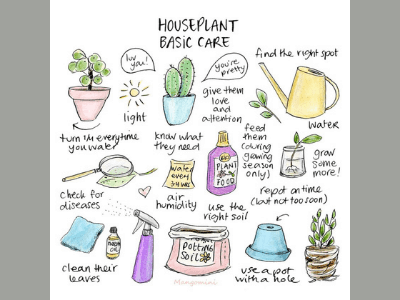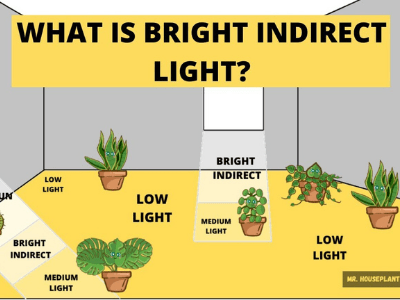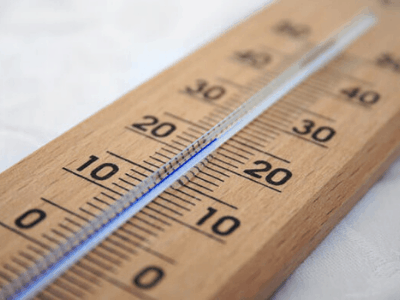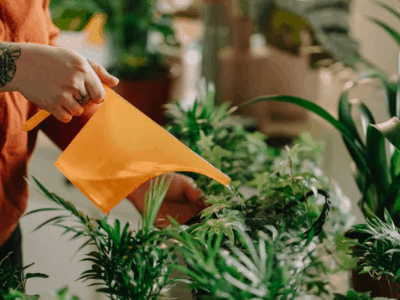Having a houseplant is the trend right now…
… especially in this pandemic era, people are stuck at home.
Caring for a houseplant kills time indoors, plus it offers lots of benefits!
Hear it from Cali!
It’s a lonely time that we live in right now, at least for me it is…
I live alone in my apartment, and my companion is only Millie – my dog…
… and a bunch of houseplants I have had since moving in.
During the first months of staying indoors, my only activity is work routine…
Other than that, I spend time on my gadget trying to fit back into the social life – virtually…
Then, I figure that I have to do something else before I got insane…
So, as I was sitting in my living room, I look around for things to do…
The one thing that caught my eyes was my houseplants!
I’ve seen my friends post a lot about their houseplants…
… and they’ve been saying that taking care of them gives a sense of peace.
So, that’s when I got my hands dirty and start my journey of gardening…
On to the main part!
For those of you having similar stories as Cali, or just trying to find a new passion…
You’ve come to the right place! This articles here is for you…
Whatever your gardening expertise, this guide will provide you with tips to care for plants that thrive.
Basic Houseplant Care

If you have difficulty growing houseplants, it might not be that you lack gardening genes…
… but that you aren’t putting the plants in the right place.
When it comes to plants, temperature, light, and humidity all play a role in whether they thrive or die…
Your home will be decorated with beautiful plants…
… and we can help you choose the right plants and where to put them.
Right Plant, Right Place
You should select plants that are suitable for the specific lighting conditions and humidity levels of your home…
Light

Light is the biggest factor in growing plants indoors.
Deborah Brown, an extension horticulturist from the University of Minnesota
In order to produce food, plants need light, but the amount required varies by plant…
Most houseplants do best in moderately bright, indirect light…
It is usually more necessary for plants with flowers or colored leaves…
… to have a higher light level than plants with green leaves.
And some species of plants, such as Chinese evergreens and cast-iron plants, tolerate low light levels…
The severity of stress is usually determined by the light levels a plant is exposed to…
Weak, spindly growth indicates insufficient light, whereas variegated foliage will lose its markings…
The leaves of plants such as scheffleras, philodendrons, ferns, and peperomias…
… will appear bleached or wilted on plants with too much light.
Fast foliage drop, most noticeable on fig species, is commonly caused…
… by abruptly moving from strong light to low light.
When the seasons and light levels change…
It might be necessary to move your plants, even if they seem to be in the perfect spot…
If plants grown directly in the sun of a south or west-facing window in winter…
… are left in that spot later in the year, when the light intensity intensifies, they may sunburn.
Move the plants out from close to the window in this case or use sheer curtains to block the sunlight…
Humidity

Typical houseplants originate from humid climates in tropical and semitropical regions…
… but they do better in humid conditions.
Most of these plants are able to adapt to the relatively drier conditions in our homes…
… but will flourish with higher humidity levels.
The leaves turn dull and papery with insufficient humidity…
… which is common during winter when most homes are heated, and their tips also turn brown.
I recommend to put indoor plants that prefer more humid air, such as ferns, in areas with higher humidity levels like bathrooms and kitchens. Alternatively, you could install a humidifier in the room with the most plants.
Matt Gardner, owner of The Wright Gardner, an interior-plantscape company based in San Francisco
There are several other ways to maintain a higher humidity level around plants…
Grouping plants together will help keep the moisture level higher…
… than allowing air to freely circulate around each one.
A shallow tray of pebbles partly filled with water can be used in the same way to keep plants on…
The pebbles will increase the surface area for evaporation…
Keep the plants out of the water otherwise the roots will rot…
Misting plants is often done in order to increase humidity, but it doesn’t actually work…
… because the moisture evaporates too quickly for plants to benefit.
Temperature

It is no accident that houseplants are called “houseplants”…
… since they require the same conditions that humans do.
They typically require the same temperature range in the daytime (upper 60s° to mid 70s°F)…
… and the same temperature range at night (10°F cooler).
However, be careful about hot or cold spots…
For example, on extremely cold winter nights, temperatures on the window sill…
… may be significantly lower than elsewhere in the room.
Unless your plants are protected, tender plants can freeze…
Keep foliage away from windows, use a heavy curtain…
… or place a piece of cardboard between the glass and the plants.
It’s not a good idea to place plants next to an exterior door or heating duct…
… since they are very sensitive to cold drafts and hot air.
Basic Care
After you place your plants in your house, you will need to water them routinely….
… and do other routine tasks to keep them healthy.
Watering

You should water your plants thoroughly, using only tepid water…
… and supplying enough to flush out excess water through the bottom hole of the pot.
It is not acceptable for the plant to stand in the drip saucer for longer than a few minutes…
Rather than using a saucer, you should empty it of water, or if the saucer is large and difficult to move…
… you can use a turkey baster to suck up the water from the saucer.
Plants thrive best when the soil is evenly moist…
Ferns, for example, do best when the soil is evenly moist…
The amount you water your plants depends on the species of plant and the conditions in your home…
In the case of plants such as cacti and succulents…
… it’s best to let the soil become completely dry between waterings.
Most houseplants, however, fall into a third category…
They need a little dry time between waterings…
Water the plants…
But wait until the soil is 1/2 to 2 inches below the surface before repeating…
Precision is impossible here, as the plant and container size…
… have a great deal to do with how long the soil should dry before watering again.
A plant’s leaves can readily be detected when they’re dehydrated…
… because they lose their shine before they wilt.
Fertilizing

It’s better to fertilize a plant sparingly. Plants tend to be over fertilized…
The sun provides plants with their own “food”…
… so fertilizer serves as a promoter of growth rather than food itself.
Too much fertilizer will do more harm than good…
For best results in spring and summer, use a houseplant fertilizer…
… labelled for houseplants with a half strength dose.
Fertilize regularly when plants are actively growing and most in need of extra nutrients…
You should reduce the amount of fertilizer in the fall, when growth slows…
… and stop fertilizing once daylight savings time ends.
Always moisten the soil before you add fertilizer to prevent roots from being burnt…
Grooming

In addition to promoting insects, dust buildup further filters light…
… so leaves receive less light and lose more nutrients.
If your plant is growing in a northern climate…
… it needs as much light as possible in winter for the production of food.
Wash leaves with a moistened cloth in tepid water to maintain the healthy soil…
Leaf shine products are not recommended because they cause the leaves to be sticky…
… attracting dust and dirt, as well as making the leaves appear unnaturally shiny.
Make sure to check for insects while you are grooming…
Mealybugs, which appear as white cottony spots, are more likely to annoy you than other insects…
Use insecticidal soap or rubbing alcohol if you do not have that handy…
Rinse with tepid water afterward. Insects such as scale insects can also be removed using the same technique…
Spider mites spin fine webs under leaves and are another common houseplant pest…
Spray the insects with insecticidal soap…
Repeated applications may be necessary before they are eradicated…
Make sure you pick plants that are appropriate…
… for your indoor environment and then provide common sense care.
Don’t push your plants to grow, just enjoy them. Oh, and check your thumb? It just turned green…
Pairing Plants With Light
Create a copy of this guide for your wallet to keep it handy when you want to purchase a plant…
The next time you buy a plant, you will be prepared…
Direct light
You can grow these in or near east- or west-facing windows…
… that receive at least a few hours of direct sunlight each day.
It’s also alright to keep them no more than a couple of feet away from a south-facing window…
- Croton (Codiaeum variegatum pictum)
- Jade plant (Crassula arborescens)
- Medicine plant (Aloe barbadenensis)
- Ponytail palm (Nolina recurvata or Beaucarnia recurvata)
Bright indirect light
Place these plants in bright locations, away from direct sunlight…
… such as close to a south- or west-facing window, or even closer if covered by sheer curtains.
- Bamboo palm (Chamadeorea seifrizii)
- Ficus alii
- Ficus jacqueline
- Fishtail palm (Caryota mitis)
- Golden pothos (Epipremnum aureum)
- Grape ivy (Cissus rhombifolia)
- Lady palm (Rhapis excelsa)
- Rubber tree (Ficus elastica)
- Spotted dumb cane (Diffenbachia maculata)
- Umbrella plant, or schefflera (Brassaia actinophylla ?Arboricola’)
- Weeping fig (Ficus benjamina)
Low light
Those plants do best in places with low light, such as near a north-facing window…
… or in a bright room away from windows.
- Cast-iron plant (Aspidistra elatior)
- Chinese evergreen (Aglaonema commutatum)
- Dracaena (Dracaena species and varieties)
- Kentia palm (Howeia species)
- Parlor palm (Chamaedorea elegans, also sold as Neanthe bella)
- Snake plant (Sansevieria trifasciata)
4 Ways to Kill a Houseplant

Many houseplants are resilient, but there are some common mistakes that can happen to all varieties:
1. You transport the plant in your trunk on a cold winter day from the nursery to your home.
Many houseplants suffer serious damage at temperatures below 50°F…
Plants need to be protected by placing them in a cardboard box with a lid…
They can also be wrapped in newspapers or paper bags, then placed on a hot seat of a car…
2. Put the pot in a drip saucer and let the water collect.
As a result, the soil becomes rich in soluble salts…
An excess of salt weakens a plant, making it more susceptible to insect attacks and disease…
3. Replace the pot with garden soil.
The soil in a pot hardens when stuffed with garden soil…
This results in poor drainage and lack of oxygen, a houseplant death sentence…
Houseplants should always be planted in high-quality packaged potting soil…
4. Plant in a container that does not have a drainage hole.
Eventually the plant will suffocate. Use a pot with a drainage hole if your favorite decorative pot lacks a hole…
If that doesn’t work, use a smaller pot that drains…
When a plant does not flourish, for example…
… because your cat relentlessly chews on its leaves, it is too messy, or it is being attacked by aphids, what can you do?
Throw away or compost your troublesome plant, then treat yourself to a new one…
To sum it up…
The houseplant guide above is a general guide you may want to look at…
But, remember that every plant species has different care requirements…
… and you should be aware about what kind of plant you have.
Adjust the requirements where necessary, and above everything else…
… take care of your houseplants with love and passion.
Conclusion
If you still have any queries after reading this article…
… or if you want to give suggestions or recommendations based on experience…
… comment down below so that we will know. You are also welcomed to contact us!
Check out more of our posts like this one here!
I hope you can now take care your snake carefully and grow it big!
Have an awesome gardening journey!


